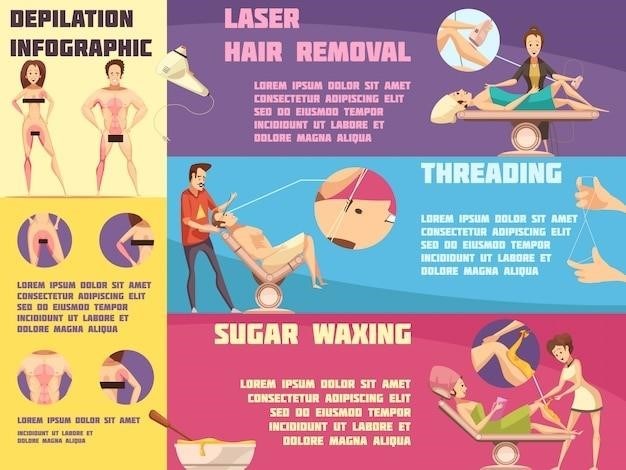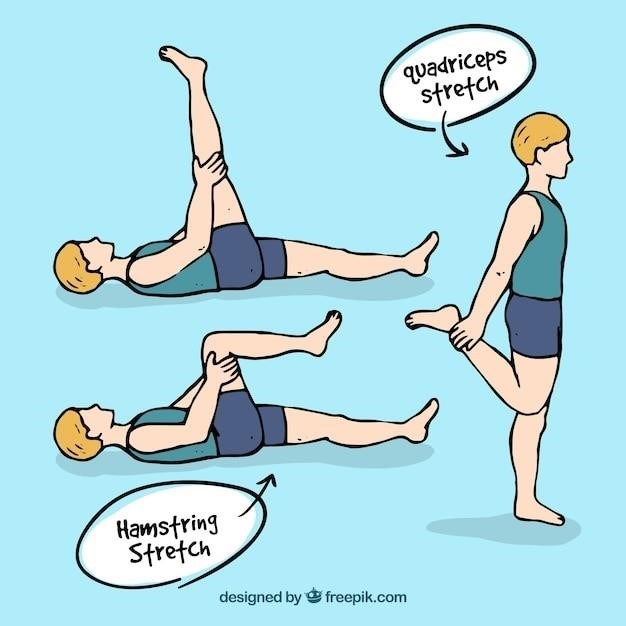
Meniscus Tear Exercises⁚ A Comprehensive Guide
This guide provides a structured approach to meniscus tear exercises, offering a range of options from initial recovery movements to advanced strengthening and stability exercises. It emphasizes the importance of physical therapy and personalized exercise plans tailored to individual tear severity. Remember to consult your doctor before starting any exercise program.
Understanding Meniscus Tears
The meniscus, C-shaped cartilage within the knee joint, acts as a shock absorber and stabilizer. A meniscus tear, a common knee injury, often results from twisting or sudden forceful movements. Symptoms can include pain, swelling, clicking or popping sensations, stiffness, and difficulty bearing weight. Tears are categorized by location (inner or outer meniscus) and severity (minor, moderate, or severe). Diagnosis typically involves a physical exam and imaging studies like MRI scans to visualize the tear’s extent. Treatment depends on the severity and location; some tears heal naturally with rest and conservative management, while others may require surgical intervention, such as arthroscopic repair or meniscectomy (partial or total removal of the damaged meniscus). Understanding your specific tear type is crucial for effective rehabilitation.
Initial Exercises for Meniscus Tear Recovery
The initial phase focuses on reducing pain and swelling, restoring range of motion, and protecting the healing tissues. Begin with gentle range-of-motion exercises, such as ankle pumps and knee extensions, performed within pain-free limits. Simple exercises like straight leg raises (keeping your leg straight and lifting it a few inches) and quad sets (tightening your thigh muscles without moving your leg) help strengthen the muscles supporting the knee. Ice application and elevation of the leg can help manage swelling. Avoid activities that put stress on the knee, such as squatting or twisting. Listen to your body and stop if you experience any pain. The goal is to gradually increase range of motion and muscle strength without causing further injury. Regularly consult with your physical therapist or doctor to adjust the exercises based on your progress.
Progressive Exercises for Strengthening the Knee
As pain and swelling subside, progress to exercises that challenge the knee joint and surrounding muscles. Introduce isotonic exercises, such as leg presses and hamstring curls, using light weights or resistance bands. These exercises help build strength and improve muscle endurance. Focus on controlled movements and proper form to avoid reinjury. Gradually increase the weight or resistance as your strength improves. Incorporate exercises that target the quadriceps, hamstrings, and calf muscles, as these muscle groups play a crucial role in knee stability and function. Consider exercises like wall sits (leaning against a wall with your knees bent) and step-ups (stepping onto a low platform). Remember to listen to your body and adjust the intensity and duration of the exercises accordingly. Maintaining consistency is key to achieving optimal results.
Advanced Exercises for Improved Stability and Function
Once sufficient strength and range of motion are achieved, progress to advanced exercises that challenge balance and coordination. These exercises help improve proprioception (the body’s awareness of its position in space), which is crucial for knee stability. Incorporate exercises such as single-leg stances, balance board exercises, and agility drills. Start with simple variations and gradually increase the difficulty as your balance and coordination improve. Consider using unstable surfaces, such as a wobble board or foam pad, to further challenge your balance. Plyometric exercises, such as jump squats and box jumps, can be introduced gradually once sufficient strength and stability are established. These exercises improve power and explosiveness but should only be performed after consulting with a physical therapist and when the knee is fully healed. Remember to listen to your body and stop if you feel any pain.
Importance of Physical Therapy
Physical therapy plays a vital role in meniscus tear recovery. A physical therapist will create a personalized exercise program tailored to your specific needs and injury severity. They’ll guide you through the exercises, ensuring proper form to prevent further injury and maximize effectiveness. Beyond exercise, physical therapists address other crucial aspects of recovery. They’ll assess your range of motion, identify any muscle imbalances, and teach you techniques to improve flexibility and reduce pain. Manual therapy, such as joint mobilization and soft tissue massage, may also be incorporated to alleviate stiffness and promote healing. Regular sessions with a physical therapist offer valuable support and accountability. They monitor your progress, make adjustments to your program as needed, and provide education on proper body mechanics to prevent future injuries. The guidance and expertise of a physical therapist are invaluable in achieving a complete and successful recovery from a meniscus tear.
Exercise Modifications for Different Tear Severities
Meniscus tear severity significantly influences the appropriate exercise approach. Minor tears might only require gentle range-of-motion exercises and gradual strengthening, focusing on low-impact activities like stationary cycling or walking. More substantial tears necessitate a more cautious and progressive approach. Initially, exercises should concentrate on reducing pain and swelling, with a gradual increase in intensity and complexity as healing progresses. For severe tears or post-surgical cases, the rehabilitation program will be more extensive and carefully monitored by a physical therapist. Weight-bearing exercises will be introduced slowly, and high-impact activities will be avoided until sufficient strength and stability are regained. The exercises might involve isometric contractions, emphasizing muscle activation without significant joint movement, gradually moving towards isotonic exercises, incorporating movement through the full range of motion. Throughout this process, pain management remains paramount. The intensity and type of exercise should always be adjusted based on the patient’s feedback, ensuring the exercises remain comfortable and do not exacerbate the injury. Regular communication with a healthcare professional ensures the exercises align with the healing process.
Preventing Future Meniscus Tears
Preventing future meniscus tears involves a multifaceted approach encompassing proactive measures to strengthen the supporting musculature and enhance overall knee stability. Regular exercise, particularly those focusing on the quadriceps, hamstrings, and calf muscles, plays a crucial role. These exercises improve joint stability and reduce the stress placed on the meniscus during activities. Maintaining a healthy weight is equally important, as excess weight increases the load on the knee joint, thus raising the risk of injury. Proper warm-up before any physical activity is essential to prepare the muscles and joints for exercise. This helps to increase blood flow to the muscles, improving flexibility and reducing the chance of injury. Likewise, cooling down after exercise allows for gradual reduction in heart rate and muscle temperature, aiding recovery and reducing the risk of stiffness or injury. Appropriate footwear provides cushioning and support, helping to absorb shock and reduce strain on the knee. Incorporating exercises that improve balance and coordination is also highly beneficial, thereby enhancing overall body control and reducing the risk of falls or awkward movements that can strain the knee joint. Finally, understanding proper movement mechanics during activities like running, jumping, or squatting can prevent unnecessary strain and stress on the meniscus.
Safe Aerobic Exercises for Meniscus Tear Recovery
Following a meniscus tear, carefully chosen aerobic exercises can aid recovery without compromising the healing process. Low-impact activities are key; these minimize stress on the knee joint while promoting cardiovascular health and overall fitness. Swimming is an excellent option, providing a full-body workout with minimal weight-bearing stress. Water’s buoyancy supports the body, reducing strain on the knee. Cycling, particularly on a stationary bike, offers a controlled and adjustable workout. Resistance can be modified to suit individual fitness levels and recovery stages. Walking, when pain-free, is a beneficial exercise. Start with short distances and gradually increase duration and intensity as tolerated. Elliptical training provides a low-impact cardio workout that mimics the motion of walking and running without the jarring impact. Always listen to your body and stop if you feel any pain. Consult with a physical therapist or doctor to determine the appropriate intensity and duration of aerobic exercise based on your specific recovery progress and the severity of your meniscus tear. Proper form and gradual progression are vital to prevent setbacks and ensure safe and effective rehabilitation;
Home Exercise Program⁚ A Sample PDF
A comprehensive home exercise program, available as a downloadable PDF, provides detailed instructions and illustrations for various exercises beneficial for meniscus tear recovery. This PDF serves as a valuable supplement to professional guidance from a physical therapist or physician. The program typically progresses through several phases, starting with gentle range-of-motion exercises to reduce stiffness and swelling. As healing progresses, the program introduces strengthening exercises targeting the quadriceps, hamstrings, and calf muscles to improve knee stability and support. The PDF includes clear instructions on proper form and precautions to avoid re-injury. It often incorporates exercises such as quadriceps sets, straight leg raises, hamstring curls, and calf raises, along with low-impact aerobic activities like stationary cycling and swimming. Visual aids, such as photographs or videos, are commonly included to enhance understanding and proper execution. Remember, this PDF is a supplementary resource; always follow your healthcare professional’s recommendations and adjust the program according to your individual needs and pain levels. The PDF should not replace professional medical advice.
The Role of a Physical Therapist in Meniscus Tear Recovery
A physical therapist plays a crucial role in guiding your recovery from a meniscus tear. Their expertise ensures a safe and effective rehabilitation process tailored to your specific needs. Initial assessments determine the extent of your injury and its impact on your knee’s function. Based on this, they create a personalized exercise program, progressing gradually from gentle range-of-motion exercises to targeted strengthening and stability exercises. Physical therapists provide hands-on treatment, including manual therapy techniques to improve joint mobility and reduce pain. They also educate you on proper body mechanics and techniques to prevent future injuries. Throughout your rehabilitation, they monitor your progress, adjust your program as needed, and provide ongoing support. Their guidance minimizes the risk of re-injury and ensures you regain optimal knee function and strength. They can also address any lingering pain or stiffness and help you safely return to your normal activities. The therapist’s expertise is crucial for a successful recovery and full restoration of function.
Return to Activity Guidelines After Meniscus Tear
Returning to your normal activities after a meniscus tear requires a careful and gradual approach. The timeline for resuming activities varies depending on the severity of the tear, the type of treatment received (surgical or non-surgical), and your individual recovery progress. Your physical therapist plays a key role in guiding this process. Initially, you’ll focus on regaining range of motion and strength through prescribed exercises. As your knee improves, you’ll gradually increase the intensity and duration of your activities. Low-impact exercises like walking and cycling are usually introduced before higher-impact ones. Your physical therapist will assess your readiness for each stage, ensuring your knee can handle the increased stress. They may use functional tests to evaluate your stability and strength before allowing you to resume more demanding activities. Listen to your body and stop if you experience pain. A phased return to sports or other strenuous activities is crucial to avoid re-injury. Complete recovery may take several weeks or even months, depending on the individual case. Patience and adherence to your rehabilitation program are essential for a successful and lasting recovery.




0 Comments